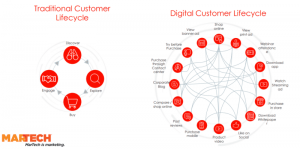— December 5, 2017

TeroVesalainen / Pixabay
It’s a question most large businesses, or at least those who are ‘lucky’ enough to have large IT teams, have struggled with. Should we resolve a particular technical requirement with a commercial, off-the-shelf solution? Or should we build it ourselves to our exact requirements – or get a third party organization to do the same?
There isn’t necessarily an easy answer to that question. There’s certainly no answer that is always true. But there are ways to think, and questions to ask, that can help you make the right decision for your business and your precise situation. In the rest of this short piece, I want to give examples of those questions, and I hope they will prove useful.
But before we go any further: a disclaimer. Yes, we sell software. That means that I can’t possibly be entirely independent on the subject, and I wouldn’t expect any reader to accept everything I say without hesitation. On the other hand, we spend a lot of time working with large organizations and we hear plenty of horror stories. We’re often the first phone call a Product Manager with burned fingers makes after it’s all gone horribly wrong. And in a purely practical sense, we’ve seen the strengths and weaknesses of both homegrown and off-the-shelf software. So I will try to be reasonably impartial
In that spirit, let us start with the positives when it comes to building your own. These can be summed up pretty easily: you will have total control over what functionality is included, and it will be tailored to suit your requirements perfectly. That is the theory at least. In addition, as time passes and requirements change, your IT team, under your direct control, will prioritize what matters to you. There is no need to juggle competing demands from multiple customers, as may be the case with an independent vendor.
All simple enough. But let’s be honest, you don’t exactly have to look very hard to find tales of woe when it comes to bespoke software projects. Like Richard II, let us pause for a moment to “sit on the ground and tell sad stories of missed deadlines, bloated budgets and general incompetence raised to previously unheard of levels” (he didn’t say the last bits).
These outcomes often occur when certain questions were not asked before deciding to build internally. That doesn’t come as a surprise. For many organizations, building is the default choice. I mean, if you have hundreds of engineers sitting around you might as well do something with them – right? In the haste to ‘get on with the job’, it is awfully easy to make a monumental – and monumentally expensive – blunder.
If you don’t want to do that, here are just a few of the questions that need to be asked, and some comments around the answers you might expect to receive. For ease-of-understanding, I’ve referred specifically to the mobile marketing space that Swrve operates in, but in most cases the responses and comments are universal. Only after having asked these questions – and satisfied yourself as to the answers – should you proceed with the build vs buy choice.
Build Vs Buy – Q & A
| Build | Buy | |
| Are you sure about what you are building? | Mobile marketing automation is a complex space – just like many others. Whilst it might be easy to build a basic analytics and push notification package, that won’t be enough. Getting this right means a long requirements gathering process (for a moving target). A tough ask. | A commercial solution is tested in the field, and has been built and tested for pretty much every use case imaginable. Although a bought-in solution won’t be exactly as specified, it will be a fair approximation of what most organizations actually need. In many ways, that’s more relevant than a list of theoretical ‘wants’. |
| Who is building it? | One thing is for sure: just because something is in-house doesn’t mean it’s free. The most basic system will require a couple of developer salaries for a year. Larger projects, and those built by third parties, can very quickly run into millions of dollars (and they don’t stop there). It is imperative to be realistic when it comes to the costs of building. | When dealing with a vendor, cost is easy to control and predictable. You’re picking up the result of years of development at a flat monthly charge, and if things aren’t as you’d like them to be contracts can be cancelled. Much harder, and costlier, to cancel an internal effort. |
| When do you need it? | It takes time to build anything, and at least a year to build a decent mobile marketing platform. We all know projects are liable to delays and that’s doubly true when attempting to juggle changing requirements and competing demands from other projects. | Off-the-shelf software is ready when you are. It really is that simple! |
| Will it scale? | Here’s the simple truth: building basic functionality is relatively easy, making it scale is hard. If you’re serious about building a world-beating mobile business, you need to be ready for many millions of users – and that will add serious cycles to your development effort. | Most vendors have architectures in place that are proven with some of the world’s largest and most popular apps. So scale is never an issue, or it certainly shouldn’t be. |
| Do you have an in-house “success team”? | Building the platform is only one stage of the journey. To get the best from any solution, you will need an organization skilled up around best practices, with an understanding around which campaigns will make a difference. Do you? As always, a product is only as good as the support structure around it. | Most vendors, or at least most good vendors, will include access to a customer success team who are ready to share lessons learned with some of the smartest mobile businesses on the planet. That’s a fast way to get the most from whatever you’ve bought (or built). |
| Is your team committed to keeping the product current? | The mobile space evolves quickly and marketing automation is no exception. Your team will need to be prepared to support a rigorous product roadmap. This can present serious issues – in many cases once a product has been delivered a team is disbanded. You’ll have to argue for ongoing access or a permanent team to keep your product current. | Vendors need to keep their product up-to-date, and the SaaS model ensures that all improvements and updates are automatic and at no extra charge. Yes, you’ll be one voice in many when it comes to roadmap decisions – but you’ll always have a product that continues to evolve. |
| Are you building for marketers? | With the best will in the world, delivering product that marketers can use effectively requires more than engineering. You’ll need to invest in design and UX development work, otherwise you’re in danger of creating something technically OK but practically useless. | Commercial products are typically sold to marketers and used by marketers. As a consequence, they are marketer-proof out-of-the-box, easy-to-use, and thus help practitioners get the job done. |
| Who is managing operations? | Once you’ve built the product, you’ll need to invest in a 24/7 operations team to keep things running and ensure no down-time for your valuable mobile users. It isn’t good enough to build a great product that falls over when put to the test – by that point it is too late. Remember to factor in what you’ll need in terms of ongoing operations support. | All included as part of the service, and usually tested to destruction by other organizations before you’ve come along! |
| Have you considered the legal landscape? | Any system that handles data relating to individuals must comply with a complex legislative framework (that gets more complex with each passing day). You’ll need to ensure internal systems are in compliance, and that you can demonstrate as much. | It would be reasonable to expect any reputable vendor to be fully in compliance when it comes to legal obligations, and continue to be so. They should also be able to reassure you on this point. Make sure you ask them to! |
| Who’s In Charge? | Building internally can produce conflict within the organization. With an internal client and another department in charge of delivery, there is an obvious risk of politics and conflict arising. At the very least, the process needs to be very carefully managed. | You’re in charge. |
Business & Finance Articles on Business 2 Community
(60)
Report Post






